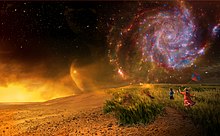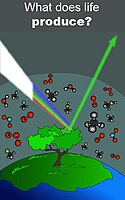Nexus for Exoplanet System Science
 NExSS poster | |
| Abbreviation | NExSS |
|---|---|
| Formation | 2015 |
| Legal status | Active |
| Purpose | To search for life beyond the Solar System |
| Headquarters | |
Parent organization | NASA |
Budget | US$10–12 million[1] |
| Website | NExSS |
The Nexus for Exoplanet System Science (NExSS) initiative is a National Aeronautics and Space Administration (NASA) virtual institute designed to foster interdisciplinary collaboration in the search for life on exoplanets. Led by the Ames Research Center, the NASA Exoplanet Science Institute, and the Goddard Institute for Space Studies, NExSS will help organize the search for life on exoplanets from participating research teams and acquire new knowledge about exoplanets and extrasolar planetary systems.[2][3][4][5][6]
History
[edit]
In 1995, astronomers using ground-based observatories discovered 51 Pegasi b, the first exoplanet orbiting a Sun-like star.[7] NASA launched the Kepler space telescope in 2009 to search for Earth-size exoplanets. By 2015, they had confirmed more than a thousand exoplanets,[note 1] while several thousand additional candidates awaited confirmation.[9]
To help coordinate efforts to sift through and understand the data, NASA needed a way for researchers to collaborate across disciplines. The success of the Virtual Planetary Laboratory research network at the University of Washington led Mary A. Voytek, director of the NASA Astrobiology Program, to model its structure and create the Nexus for Exoplanet System Science (NExSS) initiative.[1][10] Leaders from three NASA research centers will run the program: Natalie Batalha of NASA's Ames Research Center, Dawn Gelino of the NASA Exoplanet Science Institute, and Anthony Del Genio of NASA's Goddard Institute for Space Studies.[11]
Research
[edit]Functioning as a virtual institute, NExSS is currently composed of sixteen interdisciplinary science teams from ten universities, three NASA centers and two research institutes, who will work together to search for habitable exoplanets that can support life.[12] The US teams were initially selected from a total of about 200 proposals; however, the coalition is expected to expand nationally and internationally as the project gets underway.[13] Teams will also work with amateur citizen scientists who will have the ability to access the public Kepler data and search for exoplanets.[11]
NExSS will draw from scientific expertise in each of the four divisions of the Science Mission Directorate: Earth science, planetary science, heliophysics and astrophysics.[2] NExSS research will directly contribute to understanding and interpreting future exoplanet data from the upcoming launches of the Transiting Exoplanet Survey Satellite and James Webb Space Telescope, as well as the planned Nancy Grace Roman Space Telescope mission.[2]
Current NExSS research projects as of 2015:[2]
| Subject | PI | Institution | Description | Notes |
|---|---|---|---|---|
| Planetary formation and properties | James Graham | University of California, Berkeley Stanford University |
"Exoplanets Unveiled"; Direct imaging, Doppler and transit methods, using the Gemini Planet Imager of the Gemini South Telescope, the Keck Observatory, and the proposed Thirty Meter Telescope. | [14][15][16] |
| Stellar proximity and Earth-like planet formation | Daniel Apai | University of Arizona | "Earths in Other Solar Systems"; development of computer model; Large Binocular Telescope | [17][18] |
| Planetary formation | Eric Ford | Penn State University | Statistical models applied to Kepler data | [19] |
| Atmospheres of Hot Jupiters | Jason Wright | Penn State University | Diffuser-assisted photometry using ground based observatories | [19] |
| Chemistry of planetary atmospheres | Hiroshi Imanaka | SETI Institute | Habitable zones; atmosphere of Titan as an analogue to exoplanet atmospheres | [20] |
| Geochemical cycle of exoplanets | Steven Desch | Arizona State University | "Periodic Table of Planets"; geochemical modeling | [21] |
| Atmospheres of exoplanets | Drake Deming | University of Maryland | Analysis of Kepler data to study exoplanet atmospheres | [22] |
| Atmospheric evolution | William B. Moore | Hampton University | "Living, Breathing Planet". Determine past habitability of planets in the Solar System and apply results to exoplanetary habitability | [23][24] |
| Atmospheric structure and spectra of exoplanets | Jonathan Fortney | University of California, Santa Cruz | New tools to analyze exoplanet transmission spectra to identify molecular features in the atmosphere | [25] |
| Planetary formation and evolution | Hannah Jang-Condell | University of Wyoming | Modeling planet formation, focusing on transitional, protostellar disks | [26][27] |
| Formation of exoplanets | Neal Turner | Jet Propulsion Laboratory | Computer modeling of exoplanet formation | [22] |
| Exoplanet exospheres | Adam Jensen | University of Nebraska-Kearney | Detection and evolution of exospheres | [28] |
| Habitable exoplanets | Victoria Meadows | University of Washington | Virtual Planetary Laboratory (VPL) | [10][29] |
| Planetary surface habitability | Anthony Del Genio | Goddard Institute for Space Studies | Planet simulation using the GISS Earth global climate model | [30] |
| Tidal dynamics and orbital evolution of terrestrial exoplanets | Wade Henning | University of Maryland, College Park Goddard Space Flight Center |
Study of how tidal heating can prevent the ejection of young, Earth-sized planets | [19][31] |
| Detection of Earth-size exoplanets | Debra Fischer | Yale University | Design new spectrometer to detect Earth-size exoplanets; improve access to citizen science with Planet Hunters | [32] |
See also
[edit]- Astrobiology – Science concerned with life in the universe
- Astrochemistry – Study of molecules in the Universe and their reactions
- Center for Life Detection Science – Institute dedicated to the scientific search of extraterrestrial life
- Cosmochemistry – Study of the chemical composition of matter in the universe
- Carl Sagan Institute – Institute for the search of habitable worlds
- Detecting Earth from distant stars – Detecting Earth as an exoplanet
- Earliest known life forms – Putative fossilized microorganisms found near hydrothermal vents
- Extraterrestrial atmospheres – Area of astronomical research
- Extraterrestrial liquid water – Liquid water naturally occurring outside Earth
- Hypothetical types of biochemistry – Possible alternative biochemicals used by life forms
- Planetary habitability – Known extent to which a planet is suitable for life
Notes
[edit]References
[edit]- ^ a b Tollefson, Jeff (April 17, 2015). "Climate scientists join search for alien Earths." Nature 520, 420. doi:10.1038/520420a.
- ^ a b c d Loff, Sarah (April 21, 2015). "NASA’s NExSS Coalition to Lead Search for Life on Distant Worlds." NASA. Retrieved April 22, 2015.
- ^ Gronstal, Aaron L. (April 2015). "NASA's Exoplanet Nexus — Part 1: A History in Climate Studies, Part II: Looking to the Stars". NASA. GISS. Retrieved April 25, 2015.
- ^ David J. Des Marais; et al. (2008). "The NASA Astrobiology Roadmap" (PDF). Astrobiology. 8 (4): 718. Bibcode:2008AsBio...8..715D. doi:10.1089/ast.2008.0819. PMID 18793098.
- ^ a b Cofield, Calla; Chou, Felicia (June 25, 2018). "NASA Asks: Will We Know Life When We See It?". NASA. Retrieved June 25, 2018.
- ^ a b Staff (June 25, 2018). "UCR team among scientists developing guidebook for finding life beyond earth - Major series of review articles outlines past, present, and future of searching for life on other planets". University of California - Riverside. Retrieved June 26, 2018.
- ^ "NASA Taps UW Scientist in Search for Life Beyond the Solar System." University of Wyoming News. Retrieved April 25, 2015.
- ^ Schneider, J. "Interactive Extra-solar Planets Catalog". Extrasolar Planets Encyclopaedia.
- ^ Netburn, Deborah (April 24, 2015). "NASA gathers scientists to help find life beyond Earth". Los Angeles Times. Retrieved April 25, 2015.
- ^ a b Kelley, Peter (April 22, 2015). "UW key player in new NASA coalition to search for life on distant worlds." UW Today. Retrieved May 3, 2015.
- ^ a b Carreau, Mark (April 24, 2015). "NASA Widens Circle of Experts In Search for Life Beyond Earth." Aviation Week. Retrieved April 25, 2015.
- ^ Sanders, Robert (April 22, 2015). "Astronomers join forces to speed discovery of habitable worlds." UC Berkeley News Center. Retrieved April 22, 2015.
- ^ Cassidy, Chris (April 25, 2015). "NASA leaves local aerospace stars Harvard, MIT off ‘unprecedented’ mission to find extraterrestrial life." Boston Herald. Retrieved April 26, 2015.
- ^ Carey, Bjorn (April 27, 2015). "Stanford and UC Berkeley partner on NASA's new effort to detect life on other planets." Stanford Report. Retrieved April 30, 2015.
- ^ Goldberg, Logan (April 23, 2015). "UC Berkeley astronomers, Stanford physics professor lead NASA-funded project to discover habitable planets." The Daily Californian. Retrieved April 30, 2015.
- ^ Sanders, Robert (April 22, 2015). "Astronomers join forces to speed discovery of habitable worlds." UC Berkeley News Center. Retrieved April 30, 2015.
- ^ Beal, Tom (April 22, 2015). "UA, ASU teams to search for alien life." Arizona Daily Star. Retrieved April 30, 2015.
- ^ Stolte, Daniel (April 20, 2015). "UA to Join 'A-Team' in Search for Earthlike Planets[usurped]." UA News. Retrieved April 30, 2015.
- ^ a b c Cantillo, Laura; Barbara Kennedy (April 21, 2015). "New NASA coalition to lead search for life on distant worlds includes two leaders at Penn State." Pennsylvania State University Science News. Retrieved May 1, 2015.
- ^ (April 21, 2015). A New Collaboration to Aid the Search for Life on Distant Worlds. SETI Institute. Retrieved April 25, 2015.
- ^ Cassis, Nikki (April 21, 2015). "ASU team searching for signs of life in the stars." ASU News. Retrieved April 30, 2015.
- ^ a b "NASA's NExSS Coalition to Lead Search for Life on Distant Worlds." Jet Propulsion Laboratory. California Institute of Technology. April 21, 2015. Retrieved May 3, 2015.
- ^ Dietrich, Tamara (May 1, 2015). "Hampton University professor chosen to head NASA planet project." Daily Press. Retrieved May 3, 2015.
- ^ "HU research team selected to lead NASA search for life on distant worlds." HU News. April 28, 2015. Retrieved May 3, 2015.
- ^ Stephens, Tim (April 21, 2015). "UC Santa Cruz part of NASA coalition leading search for life on distant worlds." UC Santa Cruz News Center. Retrieved May 2, 2015.
- ^ Victor, Jeff (May 1, 2015). "UW professor to head NASA team." The Branding Iron. Retrieved May 3, 2015.
- ^ "NASA Taps UW Scientist in Search for Life Beyond the Solar System." Sweetwater Now. April 23, 2015. Retrieved May 3, 2015.
- ^ Gottula, Todd (April 28, 2015). "UNK faculty Adam Jensen picked for NASA exoplanet project." UNK News. Retrieved May 1, 2015.
- ^ Jensen, Kyle (April 29, 2015). "UW-led ‘super group’ boosts NASA’s quest for extraterrestrial life." Seattle Post-Intelligencer. Retrieved May 3, 2015.
- ^ Scharf, Caleb A. (April 24, 2015). NASA Goes Big and Bold for Exoplanet Science. Scientific American. Retrieved April 25, 2015.
- ^ "NASA GISS To Help Lead Search for Habitable Exoplanets". NASA, Goddard Institute for Space Studies. NASA.
- ^ Shelton, Jim (April 21, 2015). "Yale joins new NASA team searching for life outside the solar system." Yale News. Retrieved May 1, 2015.

